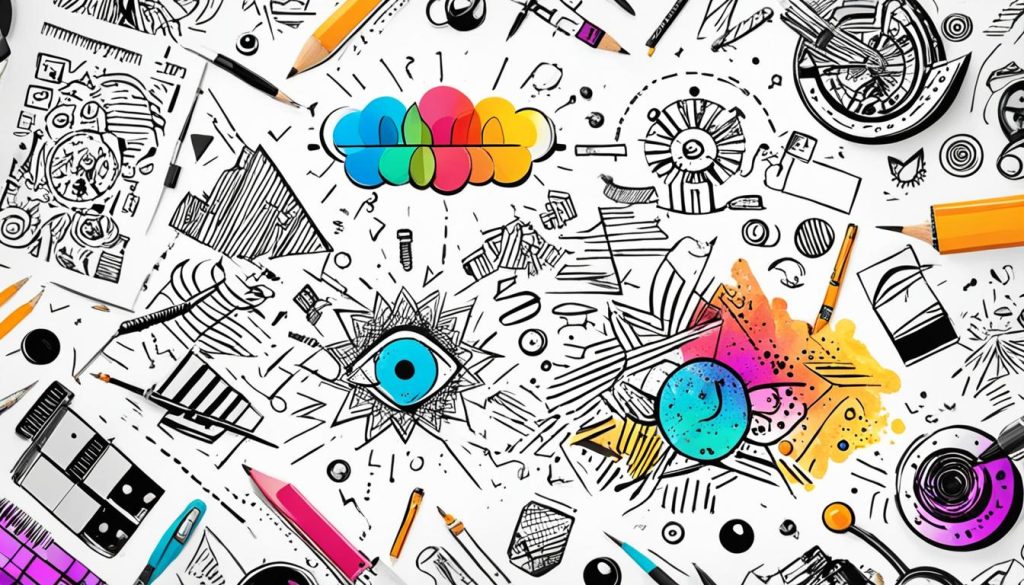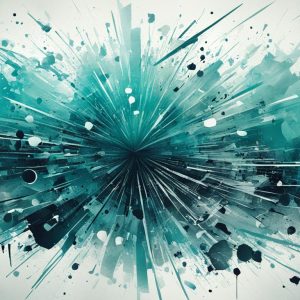Wondering what’s the difference between digital art vs graphic design? While they are certainly related, these contemporary art forms are used for different purposes. Graphic design has a broad definition, but it is best illustrated as a professional and academic discipline designed to communicate a message to a specific audience. It involves planning and projecting ideas with visual and textual content into multiple types of media. On the other hand, digital art, also called new media art, refers to art made using computers or other electronic devices. It is defined as an artistic work or practice that utilizes digital technology in the presentation process. Both graphic design and digital art have wide applications in the modern world, with graphic design being widely used in marketing and digital art finding its place in fields like architecture, VR, and AR.
Key Takeaways:
- Graphic design is a professional discipline that communicates messages through visual and textual content.
- Digital art refers to art made using computers or electronic devices and focuses on artistic expression.
- Graphic design is widely used in marketing, while digital art finds applications in fields like architecture and VR.
- Graphic design utilizes tools like Canva and Adobe Creative Cloud, while digital art uses tools like drawing tablets and Adobe Photoshop.
- The main differences lie in their purpose, elements, applications, tools, medium of consumption, approach in design, and responsibilities of artists.
What Is Graphic Design?
Graphic design is a creative discipline that involves planning and projecting ideas using visual and textual content. It serves the purpose of communicating a message to a specific audience through various mediums. From print work to web design, graphic design has become an integral part of our visual culture.
With the advent of the internet and digital technology, graphic design has evolved and expanded its applications. It plays a crucial role in marketing, where it helps create visually appealing visuals like logos, websites, and page layouts. By combining elements such as typography, imagery, and color theory, graphic designers design compelling visuals that effectively capture audience attention and convey a brand’s message.
Moreover, graphic design is not limited to marketing. It also plays a significant role in branding, contributing to the development of a company or brand’s visual identity. By creating unique and memorable visuals, graphic designers help establish a cohesive and recognizable brand image that resonates with consumers.
Graphic design is not limited to the digital realm; it has deep roots in print work as well. From designing brochures, posters, and packaging materials to creating magazine layouts and book covers, graphic design continues to impact the world of print media.
When it comes to tools and software, graphic designers have a wide array of options to choose from. Some popular graphic design tools include Canva, Design Cuts, and the Adobe Creative Cloud suite, which includes software like Photoshop, Illustrator, and InDesign. These tools empower graphic designers to bring their creative ideas to life, allowing them to craft visually stunning and impactful designs.
Overall, graphic design is an ever-evolving field that combines creativity, strategic thinking, and technical skills to create visual communication that captivates and engages audiences across various industries and mediums.
What Is Digital Art?
Digital art, also known as new media art, encompasses various mediums such as animations, photographs, illustrations, digital paintings, and videos. It refers to art created using computers or other electronic devices. While there is ongoing debate about whether digital art is considered “real” art, it requires similar design skills and creative techniques as traditional art.
In digital art, artists harness the power of technology to create visually captivating and conceptually rich artworks.
With the rapid growth of computer games, movies, and animated series, digital art has found applications in various fields. For instance, it plays a significant role in architecture, where artists use digital tools to design visually stunning structures and environments. Digital art’s ability to seamlessly blend imagination and technology has revolutionized the gaming industry and left an indelible mark on the world of films.
When it comes to digital art, various tools and software aid in the creative process. Artists often utilize drawing tablets to directly draw or paint on a digital surface. Software, such as Adobe Photoshop, provides a wide range of digital brushes and editing capabilities, enabling artists to experiment and refine their works to perfection. Additionally, 3D modeling programs allow artists to create intricate and lifelike digital sculptures.
By utilizing these tools, digital artists are able to bring their visions to life with unparalleled precision and control.
As digital art continues to evolve and push the boundaries of artistic expression, it remains an exciting and dynamic field that combines traditional artistry with cutting-edge technology.
Digital Art vs Graphic Design: Their Main Differences
When comparing digital art and graphic design, it becomes clear that there are significant differences in their purpose, elements, applications, tools, medium of consumption, approach in design, and artists’ responsibilities. Understanding these distinctions is essential in appreciating the unique contributions and roles of each discipline.
Purpose:
Graphic design primarily focuses on communicating a message through visually appealing designs. It is widely used in marketing, branding, web design, and other applications where conveying information to a specific audience is crucial. On the other hand, digital art prioritizes artistic expression and utilizes digital tools to create visual artworks, illustrations, and animations. Its purpose is more centered around personal creativity and self-expression.
Elements:
In graphic design, the core elements include typography, color theory, imagery, and layout principles, which are utilized to create visually appealing and functional designs. Digital art, while also utilizing these elements to some extent, takes a broader approach and explores various mediums, including animations, photographs, illustrations, digital paintings, and videos.
Applications:
The applications of graphic design are diverse and include marketing, branding, web design, print work, and more. It plays a significant role in creating visual identities for companies and developing brand recognition. Digital art, on the other hand, finds its applications in fields such as gaming, films, architecture, and virtual reality. It is often used to create immersive and visually stunning experiences.

Tools and Software:
Graphic designers commonly use tools and software like Adobe Creative Suite (Photoshop, Illustrator, InDesign), CorelDRAW, and Sketch. These tools enable them to create illustrations, edit images, and format layouts effectively. Digital artists, on the other hand, rely on tools such as drawing tablets, digital art software (Adobe Photoshop, Corel Painter, Clip Studio Paint), 3D modeling programs (Blender, Maya, ZBrush), and animation software (Adobe Animate, Toon Boom Harmony) to bring their artistic vision to life.
Medium of Consumption:
Graphic design is consumed through a variety of media, both digital and print-based. Its designs can be seen in advertisements, websites, brochures, and other physical forms. Digital art, in contrast, is primarily consumed online, through social media, websites, and digital galleries.
Approach in Design:
Graphic designers take a commercialized approach to design, often considering factors like brand identity, target audience, and client requirements. They aim to solve creative problems and create designs that effectively communicate a specific message. Digital artists, on the other hand, have more creative freedom and focus on individual artistic expression.
Artists’ Responsibilities:
The responsibilities of graphic designers revolve around meeting clients’ expectations, reflecting their ideas, and solving creative challenges to create visually appealing and functional designs. Digital artists, in contrast, prioritize artistic expression and leverage digital tools to create visually captivating and emotionally engaging artworks.
By understanding these main differences between digital art and graphic design, we can better appreciate and celebrate the unique contributions that each discipline brings to the creative world.
Tools Used in Graphic Design and Digital Art
When it comes to creating stunning visual artwork, both graphic designers and digital artists rely on a range of tools and software. Let’s explore some of the key tools used in graphic design and digital art:
Graphic Design Tools:
- Adobe Creative Suite (Photoshop, Illustrator, InDesign) – Widely used for creating illustrations, editing images, and formatting layouts.
- CorelDRAW – A powerful vector graphics editor that allows designers to create professional designs.
- Sketch – A popular design software specifically crafted for creating user interfaces and digital designs.
Digital Art Tools:
- Drawing Tablets – These devices allow digital artists to draw directly on a screen, simulating the experience of traditional drawing.
- Graphic Design Software (Adobe Photoshop, Corel Painter, Clip Studio Paint) – Preferred tools for creating digital paintings, illustrations, and animations.
- 3D Modeling Programs (Blender, Maya, ZBrush) – Used by digital artists to create three-dimensional models for games, films, and architectural designs.
- Animation Software (Adobe Animate, Toon Boom Harmony) – Essential software for creating captivating animations and motion graphics.
In addition to digital tools, graphic designers also rely on physical tools such as pen and paper, stylus, graphic tablets, cameras, and storage devices. These physical tools allow designers to incorporate traditional techniques and capture inspiration in the real world.
In graphic design, various design principles are applied to create visually appealing and functional designs. These principles include:
- Color Theory – The study and application of colors, their combinations, and their psychological effects on design.
- Typography – The art and technique of arranging typefaces to enhance readability, legibility, and overall visual appeal.
- Imagery – The use of relevant and impactful images to convey messages and evoke emotions.
- Layout – The arrangement of text, images, and other design elements to create a cohesive and visually balanced composition.
By utilizing these tools and principles, graphic designers and digital artists bring their creative visions to life and communicate their ideas effectively. The right combination of both digital and traditional tools allows artists to push the boundaries of visual expression and create captivating artworks.

Conclusion
In conclusion, graphic design and digital art are two distinct yet interrelated art forms. Graphic design aims to visually communicate messages and is extensively utilized in marketing, branding, and web design. On the other hand, digital art prioritizes artistic expression and employs digital tools to create visually captivating artworks, illustrations, and animations.
Both graphic design and digital art have broad applications in today’s world and rely on a variety of tools and software. However, they differ in their intent, approach, and purpose. Graphic design emphasizes clear communication and problem-solving, whereas digital art thrives on creativity and self-expression.
While there are similarities, such as the utilization of visual communication and digital tools in both fields, it is essential to recognize the distinctions between them. Graphic design plays a crucial role in conveying specific messages to targeted audiences effectively. Digital art, on the other hand, offers artists a platform to express their creativity through the use of digital technology.
In summary, graphic design and digital art contribute to the visual landscape in their own unique ways. Whether it is a well-designed logo or a visually stunning digital artwork, these art forms enhance our experiences and captivate our imagination.
FAQ
What is the difference between graphic design and digital art?
What is graphic design?
What is digital art?
What are the main differences between digital art and graphic design?
What tools are used in graphic design and digital art?
Share this content:






